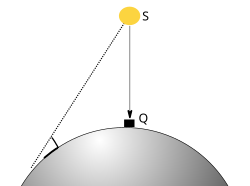Twice every year, the Sun culminates at the zenith of the Kaaba in Mecca, the holiest site in Islam, at local solar noon, allowing the qibla (the direction towards the Kaaba) to be ascertained in other parts of the world by observing the shadows cast by vertical objects. This phenomenon occurs at 12:18 Saudi Arabia Standard Time (SAST; 09:18 UTC) on 27 or 28 May (depending on the year), and at 12:27 SAST (09:27 UTC) on 15 or 16 July (depending on the year). At these times, the Sun appears in the direction of Mecca, and shadows cast by vertical objects determine the qibla. At two other moments in the year, the Sun passes through the nadir (the antipodal zenith) of the Kaaba, casting shadows that point in the opposite direction, and thus also determine the qibla. These occur on 12, 13, or 14 January at 00:30 SAST (21:30 UTC on the preceding day), and 28 or 29 November at 00:09 SAST (21:09 UTC on the preceding day).
The shadow points towards Mecca because the Sun path makes the subsolar point travel through every latitude between the Tropic of Cancer and the Tropic of Capricorn every year, including the latitude of the Kaaba (21°25′N), and because the Sun crosses the local meridian once a day. This observation has been known since at least the 13th century, when it was noted by the astronomers Jaghmini and Nasir al-Din al-Tusi, but their timings could not be fixed to a particular date because the Islamic calendar is lunar rather than solar; the solar date on which the Sun culminates at the zenith of Mecca is constant, but the lunar date varies from year to year.
